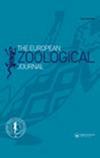First description of spatial and temporal patterns of river crossings by European roe deer Capreolus capreolus (Mammalia: Cervidae): characteristics and possible reasons
引用次数: 2
Abstract
Abstract Crossing water bodies (like lakes or rivers) by European roe deer Capreolus capreolus Linnaeus, 1758 is a known phenomenon. However, there is scarce information about the reasons for and patterns of this activity. We analysed 4-year localization data of 13 Global Positioning System-Global System for Mobile Communications (GPS-GSM) collared roe deer living in the floodplain forests of the river Tisza in the Hungarian Great Plain in order to describe such behaviour. Initially, we assumed that this river may represent a barrier for roe deer and we studied the frequency of river crossing occasions, between and within the studied animals. Our questions were: (1) Does the Tisza River act as a barrier to the movements of roe deer? (2) Are there any seasonal or daily variations in the crossing patterns? (3) Is there any difference between males and females regarding the water crossing patterns? (4) Does the water level or the increase in human presence (disturbance by hunting) have any impact on crossings? According to our data, 10 of the 13 individuals crossed the river at least twice, and eight of them did so several times or regularly. The periods spent on the different sides of the river varied from a few hours to several months. During the study period, animals of both sexes crossed the river without difference. There were crossings in all seasons, in daytime and nighttime also. We could not find any difference between the seasons, but there were more crossings in the daytime when we excluded the data of an outlier animal. Water level or human disturbance (live brown hare capture) had no impact on crossings. We conclude that the Tisza River does not represent a real barrier to the movements of roe deer, and our assumption was not supported.欧洲鹿(哺乳动物:鹿科)渡河时空格局的首次描述:特征及可能原因
欧洲狍子Capreolus Capreolus Linnaeus, 1758年穿越水体(如湖泊或河流)是一种已知的现象。然而,关于这种活动的原因和模式的资料很少。为了描述这种行为,我们分析了生活在匈牙利大平原Tisza河漫滩森林中的13只全球定位系统-全球移动通信系统(GPS-GSM)的4年定位数据。最初,我们假设这条河可能代表了狍的屏障,我们研究了被研究动物之间和内部过河的频率。我们的问题是:(1)Tisza河是否成为狍活动的障碍?(2)交叉模式是否有季节性或每日的变化?(3)雄性和雌性在渡水模式上是否有差异?(4)水位或人类活动的增加(狩猎干扰)对渡口有影响吗?根据我们的数据,13个人中有10个人至少渡了两次河,其中8个人多次或定期渡河。在河两岸度过的时间从几个小时到几个月不等。在研究期间,雌雄动物过河的次数无差异。一年四季都有渡口,白天和黑夜都有。我们没有发现季节之间的任何差异,但当我们排除异常动物的数据时,白天的交叉点更多。水位或人为干扰(捕获活褐兔)对过境点没有影响。我们得出的结论是,Tisza河并不代表狍运动的真正障碍,我们的假设不被支持。
本文章由计算机程序翻译,如有差异,请以英文原文为准。
求助全文
约1分钟内获得全文
求助全文

 求助内容:
求助内容: 应助结果提醒方式:
应助结果提醒方式:


